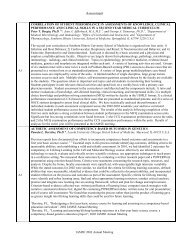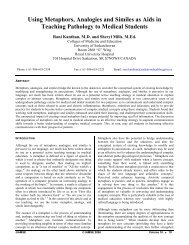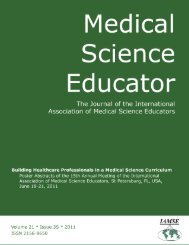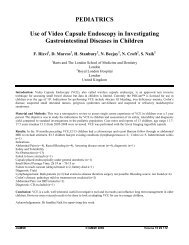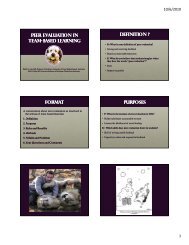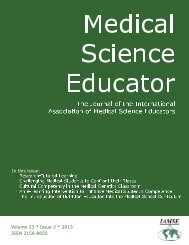Click here to view complete journal in pdf-format - IAMSE
Click here to view complete journal in pdf-format - IAMSE
Click here to view complete journal in pdf-format - IAMSE
Create successful ePaper yourself
Turn your PDF publications into a flip-book with our unique Google optimized e-Paper software.
system and ensur<strong>in</strong>g compliance with ePortfolio<br />
requirements among students, faculty, and<br />
adm<strong>in</strong>istration.<br />
CONCLUSIONS<br />
Follow<strong>in</strong>g implementation with first year medical<br />
students, the WVU SoM will expand the ePortfolio<br />
so that all students graduat<strong>in</strong>g will have an<br />
<strong>in</strong>dividualized and portable portfolio as a means <strong>to</strong><br />
evaluate career preferences and for application <strong>to</strong><br />
resident programs.<br />
TBL/PBL Abstract ID: 215 Award Nom<strong>in</strong>ee<br />
GROUP DYNAMICS OF GROUP TESTING<br />
Gregg J. S<strong>in</strong>ner, John J. Briggs, J. Charles Burns,<br />
John C. Briggs, Frazier T. Stevenson, and Stanley<br />
J. Nazian, University of South Florida, Tampa, FL,<br />
USA<br />
PURPOSE<br />
Group test<strong>in</strong>g provides an opportunity <strong>to</strong> re<strong>view</strong> and<br />
retake exam questions <strong>in</strong> randomized groups after<br />
the <strong>in</strong>dividual test. Considerable student angst is<br />
associated with this, negat<strong>in</strong>g many of the benefits.<br />
We hypothesized that greater familiarity with the<br />
group would reduce the angst.<br />
METHODS<br />
Students <strong>in</strong>itially <strong>to</strong>ok an <strong>in</strong>dividual exam. They<br />
then were placed <strong>in</strong> either pre-formed groups (from<br />
a concurrently runn<strong>in</strong>g class) or random groups.<br />
Students alternated sett<strong>in</strong>gs for each test. At the end<br />
of the year students were asked <strong>to</strong> <strong>complete</strong> an<br />
anonymous survey <strong>to</strong> gauge differences <strong>in</strong> learn<strong>in</strong>g,<br />
group dynamics, and overall op<strong>in</strong>ion.<br />
RESULTS<br />
While <strong>in</strong> pre-formed groups, personal stress was<br />
decreased <strong>in</strong> 44% of respondents and rema<strong>in</strong>ed<br />
unchanged between groups <strong>in</strong> 44% of students.<br />
T<strong>here</strong> was less conflict <strong>in</strong> 60% of respondents <strong>in</strong><br />
pre-formed groups while 26% reported no<br />
difference between groups. Hostility was three times<br />
more likely <strong>in</strong> a random group when compared <strong>to</strong> a<br />
pre-formed group (37% vs. 12%). Both teach<strong>in</strong>g<br />
(36% vs. 5%) and seek<strong>in</strong>g clarification occurred<br />
more often <strong>in</strong> pre-formed groups (45% vs. 7%) <strong>in</strong><br />
contrast <strong>to</strong> random groups. Fifty six percent of<br />
students felt that the exam was worthwhile <strong>in</strong> preformed<br />
groups compared <strong>to</strong> 8% <strong>in</strong> random groups.<br />
Group test<strong>in</strong>g should not cont<strong>in</strong>ue accord<strong>in</strong>g <strong>to</strong> 39%<br />
of respondents while 40% felt it should cont<strong>in</strong>ue <strong>in</strong><br />
some manner.<br />
CONCLUSIONS<br />
Pre-formed groups decreased stress and conflict<br />
dur<strong>in</strong>g the group exam. Students were split evenly<br />
on the value of the group exam. These data suggest<br />
that revision <strong>to</strong> test<strong>in</strong>g with<strong>in</strong> a pre-formed group<br />
may provide students with an opportunity <strong>to</strong> teach<br />
each other with decreased stress and anxiety.<br />
TBL/PBL Abstract ID: 216<br />
NEW APPROACH TO ASSESSING<br />
STUDENTS’ DEVELOPMENTAL<br />
PROGRESSION IN A PROBLEM-BASED<br />
LEARNING CURRICULUM<br />
Deana M. Richter, Robert Orlando, Paul McGuire,<br />
Jonathan Eldredge, Teresita McCarty, Steve<br />
Mitchell, Ann Morrison, Deepti Rao University of<br />
New Mexico School of Medic<strong>in</strong>e, Albuquerque, NM,<br />
USA<br />
PURPOSE<br />
Problem-Based Learn<strong>in</strong>g (PBL) provides<br />
opportunities for skills development and stimulates<br />
life-long learn<strong>in</strong>g. Feedback <strong>to</strong> students, however,<br />
often focuses on knowledge rather than skills. While<br />
faculty <strong>in</strong>vest a lot of energy on assessment, the<br />
process tends <strong>to</strong> be impressionistic, <strong>in</strong>consistent,<br />
and limited <strong>in</strong> scope, mak<strong>in</strong>g it difficult <strong>to</strong> track<br />
student progress over time. To address this, we<br />
implemented a behaviorally anchored rubric <strong>to</strong><br />
assess progressive development of skills across the<br />
curriculum <strong>in</strong> PBL.<br />
METHODS<br />
It is important that the rubric address mastery of<br />
skills <strong>in</strong> PBL <strong>in</strong>dependent of specific subject matter<br />
of <strong>in</strong>dividual courses. Developed through an<br />
iterative analytic <strong>in</strong>duction process, the rubric<br />
<strong>in</strong>cludes a global rat<strong>in</strong>g scale that assesses two areas<br />
of proficiency: Communication & Teamwork,<br />
Cl<strong>in</strong>ical Reason<strong>in</strong>g & Application of Knowledge.<br />
Three levels of proficiency reflect developmental<br />
progression: emerg<strong>in</strong>g, acquir<strong>in</strong>g, mastery. Global<br />
rat<strong>in</strong>gs for each block are summed at the end of a<br />
year. Students pass if they meet a pre-established<br />
m<strong>in</strong>imum standard, which <strong>in</strong>creases across time <strong>in</strong><br />
a developmental progression.<br />
RESULTS<br />
The rubric is currently be<strong>in</strong>g piloted <strong>in</strong> the medical<br />
school curriculum. Data are not yet sufficient for<br />
quantitative evaluation. Initial feedback from tu<strong>to</strong>rs<br />
and students has been overwhelm<strong>in</strong>gly positive.<br />
Tu<strong>to</strong>r tra<strong>in</strong><strong>in</strong>g poses a major challenge.<br />
Medical Science Educa<strong>to</strong>r © <strong>IAMSE</strong> 2012 Volume 22(4S) 321



